Raising Monarchs
One humid morning of July 22nd I had a few hours to myself as Chris took Forest to get a haircut and do a few errands. With a plethora of ways I could spend that time I opted to start working on weeding the flower garden path. I worked, head down, for the better part of an hour and a half and was making good progress. Taking a break to rest my neck from the strain of looking down, I happened to look up right at the moment a female monarch was visiting one of the milkweed patches. I watched her and sure enough her ovipositor was dotting the milkweed leaves with eggs!
I’d been itching to start raising some monarch eggs this season, to give the new monarch tent a test run and here was my opportunity. I’d read off an on about raising monarchs but because it was never something that I was going to be immediately doing I never delved too far into the research. So, off I went to do a little more reading and fashioned up a container to hold the eggs (still attached to their milkweed leaf) until the caterpillars hatched. A large yogurt container worked perfectly and out I went, looking for eggs. I had a good idea where eggs had been laid but it took some time to peer under each leaf to find them. I ended up with 8 eggs that afternoon.
Every day for the next five days I checked the container looking for hatchlings but none were there until the morning of 7/26 when all but one had hatched! I kept the unhatched one in the yogurt container and moved the other seven to an old Tupperware plate and put a few leaves of milkweed in it and put them into their tent on the back porch. The final egg hatched overnight the following day.
It was exciting to have these teeny tiny little beings that are, at first instar, resemble nothing like what you would recognize as a monarch caterpillar. But they were hungry little creatures and their frass resembled pepper at that point. It was easy to move the leaves to a temporary holding station and dump the frass out, wipe it if needed, and put the leaves back.
That weekend I was planning on attending my niece and nephew’s birthday party up in DFW so I knew I would need to take the caterpillars with me. I had read that people used floral tubes to keep the stems of milkweed fresher and from drying up as fast as they do without being in the tubes, but getting to a store to buy those hadn’t been easily accessible to me. Since I was going to be at my parent’s house that weekend I knew I could pop into a hobby store easily and get some. While I also had three individual plants potted up that I could have taken with me, I only threw some fresh leaves onto the plate and packed the caterpillars up in the back of my car for the ride up to DFW. I had confirmed with my mom that she still had plenty of milkweed in her yard so I wasn’t worried about having milkweed for the weekend.
It was on the drive up there that evening that I remembered my dad sprayed their backyard for mosquitoes. They have a horrible problem with them, everyone gets eaten to pieces up there if you spend any time in the yard, so I don’t fault them for trying to control that. But I wondered about what the spray was he was using. Because if there is one thing I’ve learned is that chemicals are not actually as targeted as people like to think. The bottle might say it is for a specific pest but if you actually read the label the list of other species targeted usually gets broader. This particular bottle including several caterpillars in its fold out information sheet and that sealed the deal—Mom’s milkweed wasn’t going to work. Now, my dad had sprayed several weeks prior but the label indicated the chemical was supposed to keep working for, I think, up to two months. I wasn’t willing to chance it.
I was left with trying to buy non-chemically treated milkweed if I could find it or look for wild milkweed. I had previously known there were milkweed patches in some empty fields a few blocks from their house but after almost 32 years of living in that house those fields had now become houses. This was a recent development, too, within the last year. I could not find milkweed close-by. Another alternative was to hit up Tandy Hills Natural Area in east Fort Worth. We were heading to that part of town for dinner Saturday evening so I kept an eye out for milkweed on the way and knew we could likely get some from Tandy Hills if I didn’t see any. I spotted some milkweed in some fields off of Beach Street, between Tx 121 and I-30 and made a mental note to stop there if none was found at Tandy Hills. Well, none was found at Tandy Hills so we pulled off on our way home to those empty lots and I grabbed a few leaves to tide them over until I got home the following day.
In between this time, two caterpillars disappeared. I later learned monarch caterpillars can cannibalize each other. Oh, great! I suppose I could have also lost them when I was changing out their plates but I was trying to be careful, so who knows. The milkweed I had found on Beach Street was green milkweed, Asclepias viridis, and I knew I could find more on my way home along I-35, along the strips between the highway and the access roads, on my way home. Sure enough, just outside of the far suburbs of Fort Worth the milkweed started showing up more. I popped off one exit and slowly drove the access road before I pulled over to run out and grab a few more leaves to supplement them until we got home. That made the caterpillars happy and I was glad to pop in some fresh leaves into the floral tubes I had bought while in Fort Worth.
My lesson in all of that is not to trust that chemicals aren’t being used on your planned milkweed stock and that your previously known wild milkweed habitat might now be human habitat instead.
After all of that, things went along swimmingly for the most part. One caterpillar did die after we returned home; I’m not sure if the stress of trying to figure out the milkweed situation did that or if it would have happened anyway, but I was sad about that happening. I had originally collected eight eggs and was now down to five caterpillars and I wanted to have those five succeed into becoming butterflies.
Over the next few days they changed instars, molting and growing up. Along with that was a more voracious appetite so I began moving planting into the tent. The tent I had flagged on Amazon that my MIL had bought for me for my birthday was fine and worked great but I quickly realized that I really should have gotten one that was a little taller on all sides so that my plants would fit in there properly. I ended up flipping the tent tall-wise, which put the plastic bottom as a side instead of a bottom and one of the shorter mesh ends as the bottom. I still had to trim off the top of the plants I put in there and I ended up putting the tops into floral tubes for them to chow. Since then I have gone around the milkweed patches looking for smaller, single plants to pot up and now have more containers that I can switch out. For further caterpillars I raise I will likely employ more of the floral tubes with leaves until I can get my plants recovered and new leaf growth going.
By the following weekend of 08/4-08/05 they were all in instars 4 or 5, and getting fat and happy. Frass was now the typical pellets you see for larger caterpillars so it was harder to clean out. Now that the caterpillars were on plants I could easily just take the plants out and dump out the frass into the flower beds and be done with it. The only bad part was staining on the mesh because I’d had to flip the tent. I think I will put a towel down on that for subsequent rounds.
One caterpillar was noticeably slowing down on Sunday 08/06 and I suspected it was going to pupate soon. Sure enough when I woke up on Monday 08/07 we had a chrysalis! It had formed on a leaf and I didn’t think much of it but when I came home at lunch I found another caterpillar had brazenly eaten around the chrysalis; the chrysalis had been attached to the mid-rib of the leaf, and now the leaf was having trouble supporting itself on the plant and had bent over. I cut the leaf off and found a stick and taped it up to the stick and to one of the containers. I knew that people regularly moved chrysalides, using pins or super glue to stick them other places, or using floss to tie them to something else. Being a newbie to this whole thing I was nervous about doing any of that. Since the chrysalis looked fine attached to the sturdy mid-rib of the leaf I thought it would be fine how it was.
The other four kept chowing down and then the second went into chrysalis overnight 08/7-08/08. And then the third I found the morning of 08/09. The evening of 08/08 I had been having to repeatedly move two of them because they were actively searching for a place to pupate but were huddled up next to the zipper of the tent, not a good place to be! Finally they got the hint and moved to different places that were much safer for them to be and began getting themselves ready to pupate. When I came home from lunch on 08/09 I found one of them in the middle of pupating, a situation I had never seen before and had only recently watched on YouTube. It happens so fast, much faster than I imagined! I was planning on working out during my lunch break and when I left the last caterpillar was in its J form and when I got back it had completely pupated. I was gone for about thirty minutes. Quick!
After that things were relatively quiet for a few days. I tried to move some of the frass out of the bottom that I could without disturbing everyone but it was difficult to do. On 08/12 I noticed chrysalis #2’s leaf had started dying so I really needed to move it and that prompted me to finally research securing them by other means. A few YouTube videos and I was more confident so I grabbed my floss and got myself together and got out there to fix the two chrysalides that needed help. First I tied up and secured the first one I had moved because it was easier to get to and would be a good trial run of the process. It was easy so that helped me feel better about doing the second, which also went fairly easily.
On Sunday 08/13 I noticed that the first chrysalis was darkening along the bottom, slowly getting darker along the entire chrysalis by the next day. That Monday evening I wondered when it would eclose and by Tuesday morning I had my answer with a butterfly hanging outside of the chrysalis drying its wings! That happened a lot faster than I expected!
By this time the second chrysalis was also darkening and now that I knew how fast the transformation went I was ready for another one on Wednesday morning. Sure enough when I got downstairs Wednesday morning the second one had its wings completely unfurled and a third had had eclosed but had its wings still crumpled a bit. It was definitely fresh out of the chrysalis! The last two were very dark in their chrysalis and you could see their wings; they would emerge that morning while I was at work, that was plain to see.
When I got home for lunch on Wednesday all four were emerged and the two from that morning were very active and ready to get going and out into the world. I opened the tent and after a little hesitation the first two flew out and fluttered off into the world. The other two that had only emerged a few hours earlier weren’t quite ready and were content to beat their wings just a little and continue hanging from the top of the tent. I let them be and kept them for evening when Forest would be around to help release them. In all there were four males and one female.
After they were released, it took some getting used to not looking out the back door to the tent to see how the caterpillars were faring. Yesterday I cleaned up the tent. I’ve been watching for more females visiting the milkweed to deposit eggs but until yesterday morning I had only been seeing a variety of males nectaring in the garden. Some of them have had quite a trek as they’ve moved south, with wings beaten up and worn. One opted to end his life cycle in the garden. I found him laying in the middle of the path with fire ants trying to work on decomposing him. Life.
I did finally see a female depositing eggs yesterday morning so Forest and I went out searching for more eggs. Because I wasn’t actively looking where she was laying her eggs at the time it took a little more effort to find the eggs and I came out with ten. I am sure there are more, though.
And so I’ll go for round two!
Resources:
How to Raise Butterflies Inside
Raising Monarch Resources
Part I: How to Raise Monarch Butterflies at Home
How to Raise Monarch Butterflies at Home Yes, this is a different link but similar title.













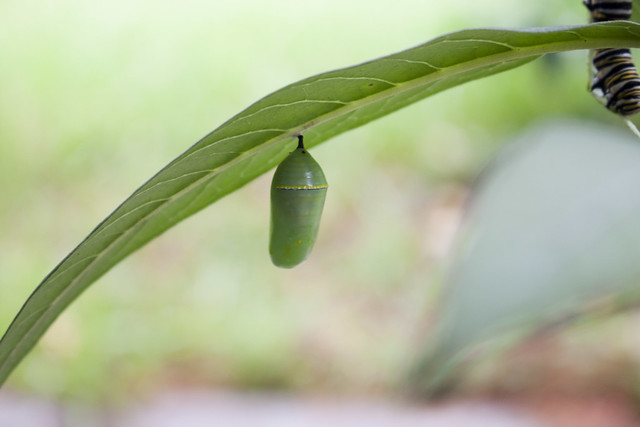


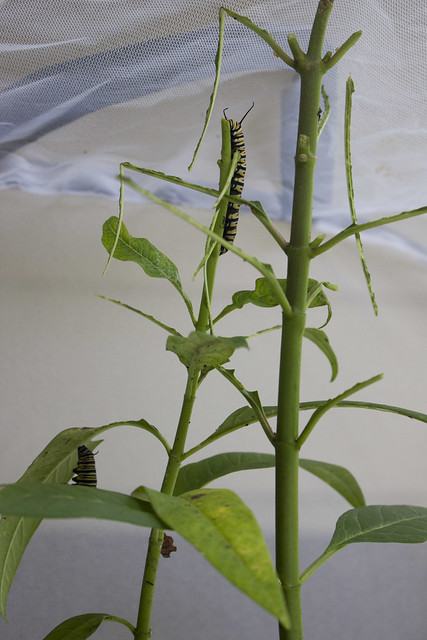
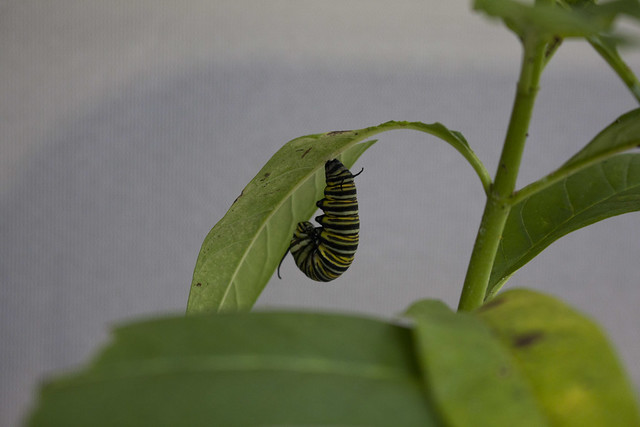












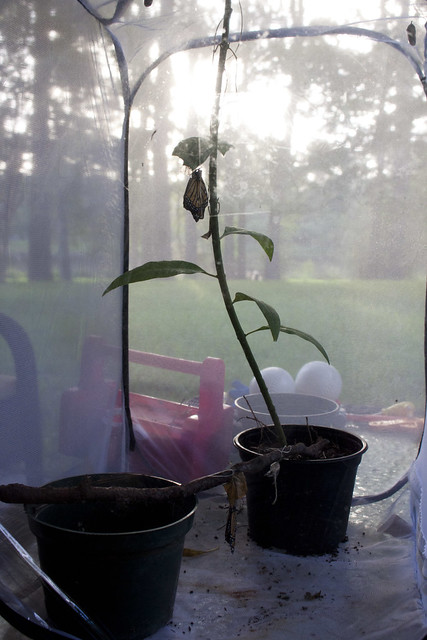







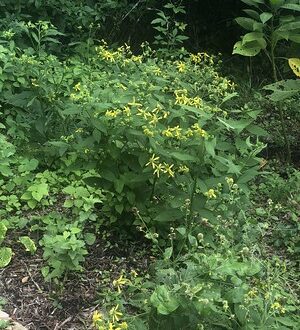
2 Comments
Patrice La Vigne
Wow!!! What an ADVENTURE! Who knew??? Lots of work, lots of research, good for you.
Pingback: